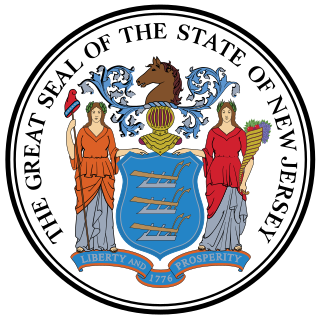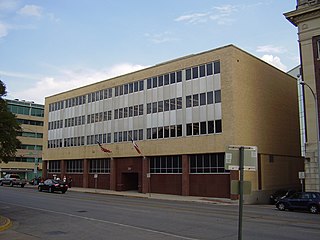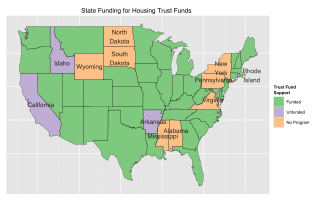
The United States Department of Housing and Urban Development (HUD) is a Cabinet department in the executive branch of the United States federal government. Although its beginnings were in the House and Home Financing Agency, it was founded as a Cabinet department in 1965, as part of the "Great Society" program of President Lyndon Johnson, to develop and execute policies on housing and metropolises.
The Low-Income Housing Tax Credit is a dollar-for-dollar tax credit in the United States for affordable housing investments. It was created under the Tax Reform Act of 1986 (TRA86) and gives incentives for the utilization of private equity in the development of affordable housing aimed at low-income Americans. LIHTC accounts for the majority of all affordable rental housing created in the United States today. As the maximum rent that can be charged is based upon the Area Median Income ("AMI"), LIHTC housing remains unaffordable to many low-income renters. The credits are also commonly called Section 42 credits in reference to the applicable section of the Internal Revenue Code. The tax credits are more attractive than tax deductions as the credits provide a dollar-for-dollar reduction in a taxpayer's federal income tax, whereas a tax deduction only provides a reduction in taxable income. The "passive loss rules" and similar tax changes made by TRA86 greatly reduced the value of tax credits and deductions to individual taxpayers. Less than 10% of current credit expenditures are claimed by individual investors.
Section 8 of the Housing Act of 1937, often called Section 8, as repeatedly amended, authorizes the payment of rental housing assistance to private landlords on behalf of low-income households in the United States. Fort Lauderdale, Florida Housing Authority Director William H. Lindsey, upon the advice of Housing Authority attorney J. Richard Smith, initially developed 11(b) financing in the early 1970s to accommodate a local savings and loan interested in assisting with urban renewal projects Mr. Lindsey eventually brought to fruition. This was the initial impetus for the subsequent development of the now well known Section 8 Program. Of the 5.2 million American Households that received rental assistance in 2018, approximately 1.2 million of those households received a Section 8-based voucher. 68% of total rental assistance in the United States goes to seniors, children, and those with disabilities. The U.S. Department of Housing and Urban Development manages Section 8 programs.

Canada Mortgage and Housing Corporation (CMHC) is a Crown Corporation of the Government of Canada. Its superseding agency was established after World War II, to help returning war veterans find housing. It has since expanded its mandate to assist housing for all Canadians. The organization's primary goals are to provide mortgage liquidity, assist in affordable housing development, and provide unbiased research and advice to the Canadian government, and housing industry.
The Community Planning and Development agency within the United States Department of Housing and Urban Development (HUD) administers the grant programs that help communities plan and finance their growth and development, increase their capacity to govern, and provide shelter and services for homeless people. HUD is a national program, and HUD provides funding directly to larger cities and counties, and for smaller cities and counties, generally to state government. HUD's programs include the Community Development Block Grant Program and the HOME program.
New Community Corporation (NCC) is a not-for-profit community development corporation based in Newark, New Jersey. NCC focuses on community organizing, provision of a variety of community-enhancing services, and resident participation in agency operation. Early prototypes of the community action movement included local housing and service agencies started by the Ford Foundation Gray Areas Initiative and the United States Office of Economic Opportunity, and both federal and private Mobilization for Youth in New York City.

Nehemiah Corporation of America is a non-profit organization based in Sacramento, California specializing in homeownership, affordable housing and community development. It started in 1994 as a small organization, but grew to prominence later in the 1990s after it developed a program that allowed home buyers to make down payments on their purchases using funds that were derived from the home sellers. This program, the Nehemiah Program, became popular and was widely emulated, giving birth to what came to be known as the seller-funded down-payment assistance industry. The industry attracted criticism from U.S. federal agencies and was ultimately shut down in 2008 by a change in federal law.
The New York State Housing Finance Agency (HFA) is a New York State public-benefit corporation created in 1960 to build and preserve affordable multifamily rental housing throughout New York State. HFA sells bonds and uses the proceeds to make mortgages to affordable housing developers. It and its subsidiaries are now administered by New York State Homes and Community Renewal.

The New Jersey Department of Community Affairs is a governmental agency of the U.S. state of New Jersey. The department is headed by Commissioner Sheila Oliver, who is also serving as Lieutenant Governor of New Jersey.

The Texas Department of Housing and Community Affairs (TDHCA) is the state's lead agency responsible for homeownership, affordable rental housing, community and energy assistance programs, and colonia activities serving primarily low income Texans. The Manufactured Housing Division of TDHCA regulates the manufactured housing industry in Texas. The Department annually administers more than $400 million through for-profit, nonprofit, and local government partnerships to deliver local housing and community-based opportunities and assistance to Texans in need. The department is headquartered at 221 East 11th Street in Austin.

The Native American Housing Assistance and Self-Determination Act of 1996 (NAHASDA) simplifies and reorganizes the system of providing housing assistance to federally recognized Native American tribes to help improve their housing and other infrastructure. It reduced the regulatory strictures that burdened tribes and essentially provided for block grants so that they could apply funds to building or renovating housing as they saw fit. This was in line with other federal programs that recognized the sovereignty of tribes and allowed them to manage the funds according to their own priorities. A new program division was established at the Department of Housing and Urban Development (HUD) that combined several previous programs into one block grant program committed to the goal of tribal housing. The legislation has been reauthorized and amended several times since its passage.
Deborah VanAmerongen joined Nixon Peabody as a strategic policy adviser in February 2010. She works closely with attorneys in the firm's Affordable Housing practice to provide advice to developers, owners, and managers of affordable housing, as well as their financing partners, in the preservation and production of affordable housing nationwide.
The Vermont Housing Finance Agency (VHFA) is chartered as a private non-profit agency to finance and promote affordable housing opportunities for low- and moderate- income Vermonters. They are located in Burlington, Vermont.

Housing trust funds are established sources of funding for affordable housing construction and other related purposes created by governments in the United States (U.S.). Housing Trust Funds (HTF) began as a way of funding affordable housing in the late 1970s. Since then, elected government officials from all levels of government in the U.S. have established housing trust funds to support the construction, acquisition, and preservation of affordable housing and related services to meet the housing needs of low-income households. Ideally, HTFs are funded through dedicated revenues like real estate transfer taxes or document recording fees to ensure a steady stream of funding rather than being dependent on regular budget processes. As of 2016, 400 state, local and county trust funds existed across the U.S.
Non-profit housing developers build affordable housing for individuals under-served by the private market. The non-profit housing sector is composed of community development corporations (CDC) and national and regional non-profit housing organizations whose mission is to provide for the needy, the elderly, working households, and others that the private housing market does not adequately serve. Of the total 4.6 million units in the social housing sector, non-profit developers have produced approximately 1.547 million units, or roughly one-third of the total stock. Since non-profit developers seldom have the financial resources or access to capital that for-profit entities do, they often use multiple layers of financing, usually from a variety of sources for both development and operation of these affordable housing units.

Howard County Housing is the umbrella organization for the Howard County Department of Housing and Community Development and the Howard County Housing Commission. The Department is Howard County Government’s housing agency and the Commission is a public housing authority and non-profit. Both have boards that meet monthly.
The Texas State Affordable Housing Corporation (TSAHC) is a nonprofit affordable housing provider in Texas.
The Rental Assistance Demonstration is a federal housing program that was enacted as part of the Consolidated and Further Continuing Appropriations Act, 2012, and is administered by the U.S. Department of Housing & Urban Development (HUD). Broadly, the purpose of the Rental Assistance Demonstration is to provide a set of tools to address the unmet capital needs of deeply affordable, federally assisted rental housing properties in order to maintain both the viability of the properties and their long-term affordability. It also simplifies the administrative oversight of the properties by the federal government. Specifically, RAD authorizes the conversion of a property's federal funding from one form to another, where the initial form presents structural impediments to private capital investment and the new form is not only familiar to lenders and investors but, since its enactment in 1974, has leveraged billions in private investment for the development and rehabilitation of deeply affordable rental housing.

Affordable housing is housing which is deemed affordable to those with a median household income as rated by the national government or a local government by a recognized housing affordability index. The challenges of promoting affordable housing varies by location.
The Troy Housing Authority (THA) is a public agency of the city of Troy, New York that provides subsidized public housing to low- and moderate-income families and individuals, and is the pass-through agency for funding from various housing-related federal programs.









